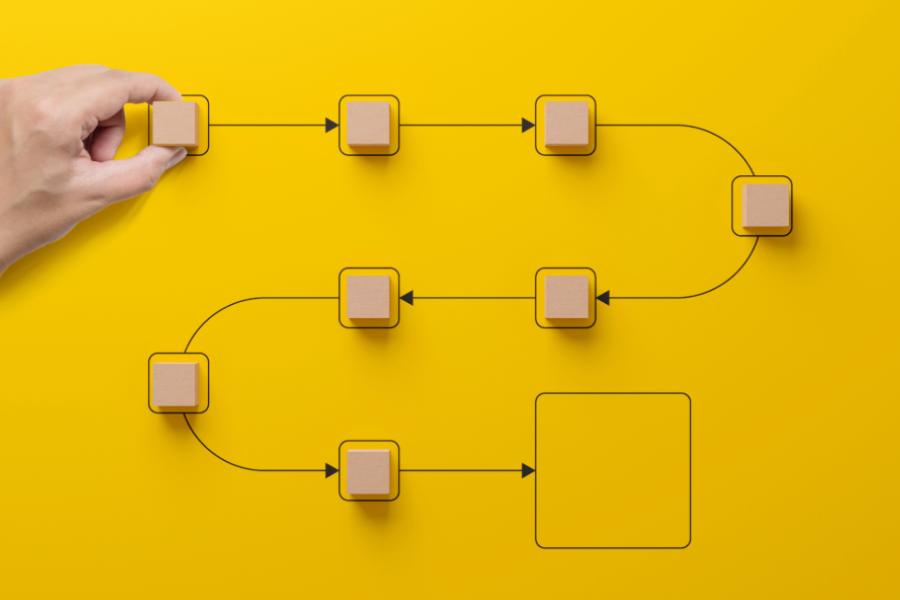We’re at the midpoint of our series of articles exploring how habits (mostly subconscious behaviors) influence our days and save mental energy. We’ve learned how habits can both aid and hinder our goals, and we’ve seen that mastering habit formation is the key to making automatic processes our allies rather than obstacles.
Next, we examined the interplay between habit development and behavioral adjustments. The keys to transforming or creating new habits are clear goals, self-reflection, and being prepared to nurture or adjust our actions for success. Commitment to habit formation and behavioral change is important, especially for complex habits. We learned the more complicated the habits – such as those related to physical activity or weight loss – the more our intentions and beliefs must be aligned.
Now, we enter the practical heart of our series – the “how it’s made” segment – where we will unravel the mechanisms and nuances of habit formation. This installment offers a comprehensive, step-by-step guide drawing from the best of current research findings.
Let’s grab some stale theater popcorn and get to it!
An in-depth habit formation loop
Let’s start by reviewing a detailed process loop (below) that guides you from setting a goal to the formation of a habit. This loop stands out as one of the most specific and research-backed flowcharts on habit formation. We have all the players here: Wood, Gardner, Lally, and Verplanken are the who’s who of habit research.
Our aim here is to peel back the layers and learn how habits tick. We’ll break it down in a way that’s technical enough to satisfy your curiosity but friendly enough not to overwhelm. Once we’ve got a solid grip on the basics, we’re going to bring it to life with a couple of examples that are tied directly to the goals of our ongoing case studies, making sure we see theory in action.
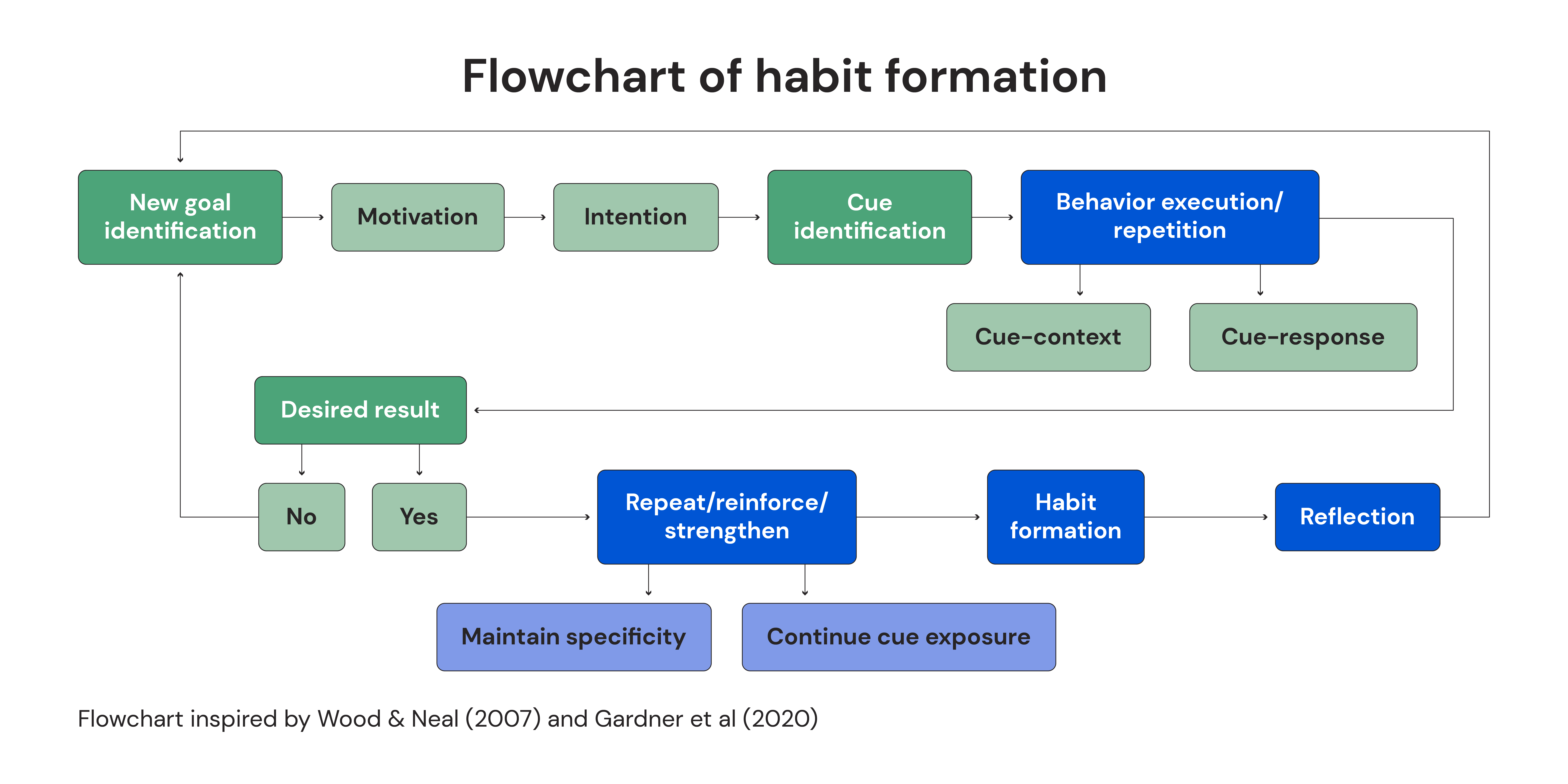
Steps for habit formation
- Goal identification: Setting a specific goal to achieve via habit formation.
- Motivation: The driving force behind achieving a habit.
- Intention: Making a conscious choice to steer your actions toward a new habit.
- Cue identification: Recognizing the trigger, event, or environment setup that initiates the action behavior.
- Behavior execution / Repetition: The repeat performance of the action behavior set off by the cue.
- Cue context: The stable and consistent trigger, environment, or event where the action occurs.
- Cue response: The action that follows the cue.
- Result: The outcome of the action behavior.
- No: Revisit goal setting and re-analyze your motivation and intention.
- Yes: Continue habit strengthening.
- Repeat, reinforce, and strengthen: The process of reinforcing the action through repetition.
- Maintain specificity: Maintaining the same cue context and response.
- Continue cue exposure: Continually expose oneself to the cues that drive the behavior.
- Habit formation: The successful automaticity and strengthening of the habit.
- Reflection: Introspection on the habit formation journey and evaluation of possible new goals.
Goal identification, motivation, and intention
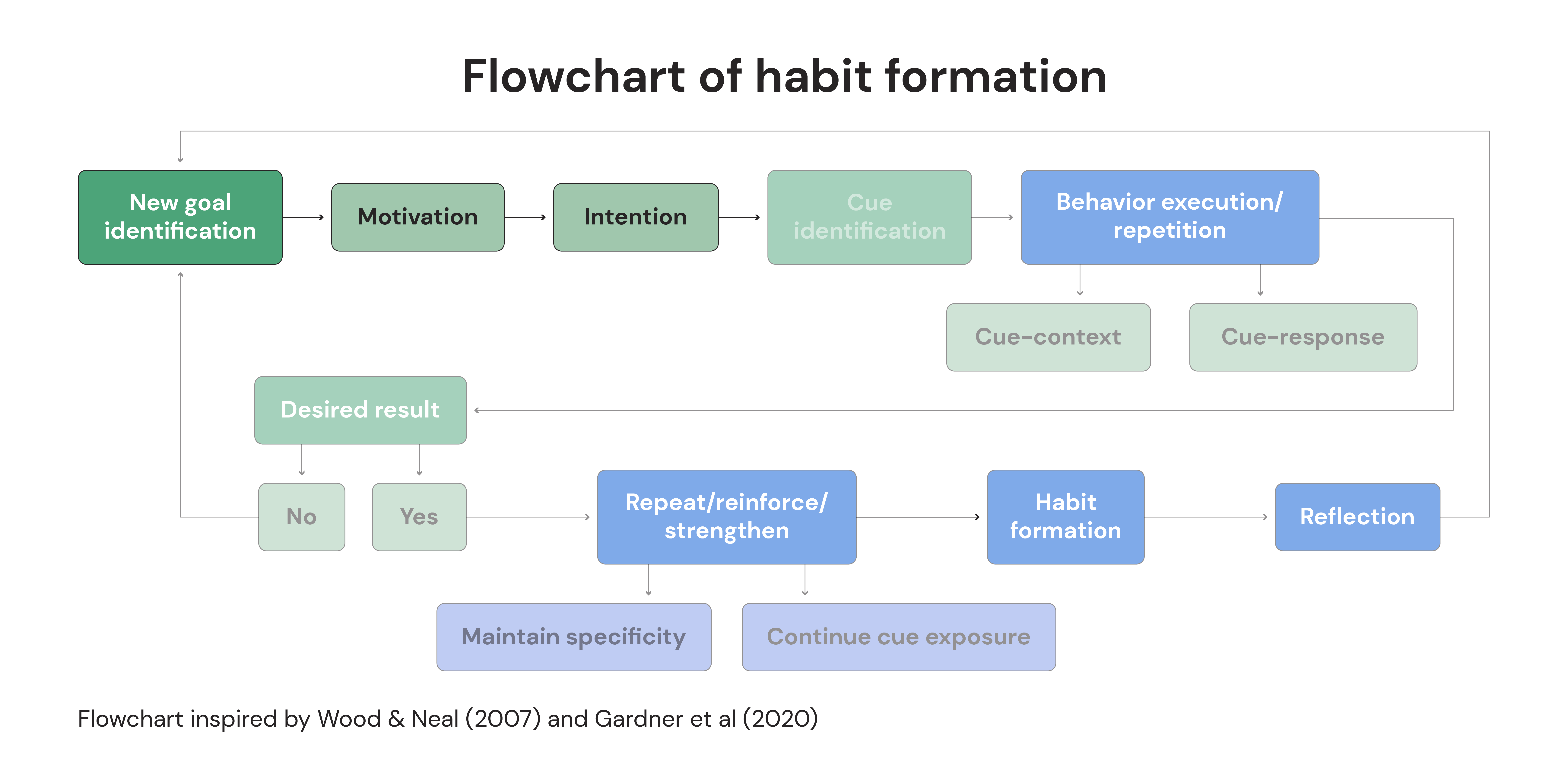
We dug into these crucial aspects of habit formation in our second article and touched on them in other pieces on the MacroFactor website. If you haven’t read those yet, I suggest you do. They serve as valuable complements to this series and offer a broader understanding to the discussion here.
While teaching you each element of habit formation, I’m selecting a pretty simple goal of “brushing your teeth before bed.” It’s straightforward and a great way to see habit formation in action. For motivation, we’re leaning on something we all appreciate: the value of good dental hygiene. And though I’ll bring in examples involving exercise and nutrition later on, starting with this basic habit helps make the process more approachable.
- Goal identification: “Brushing my teeth nightly before bed.”
- Motivation: “To achieve healthier dental hygiene.”
- Intention: “My intention is to brush my teeth before bed every night.”
Cue Identification
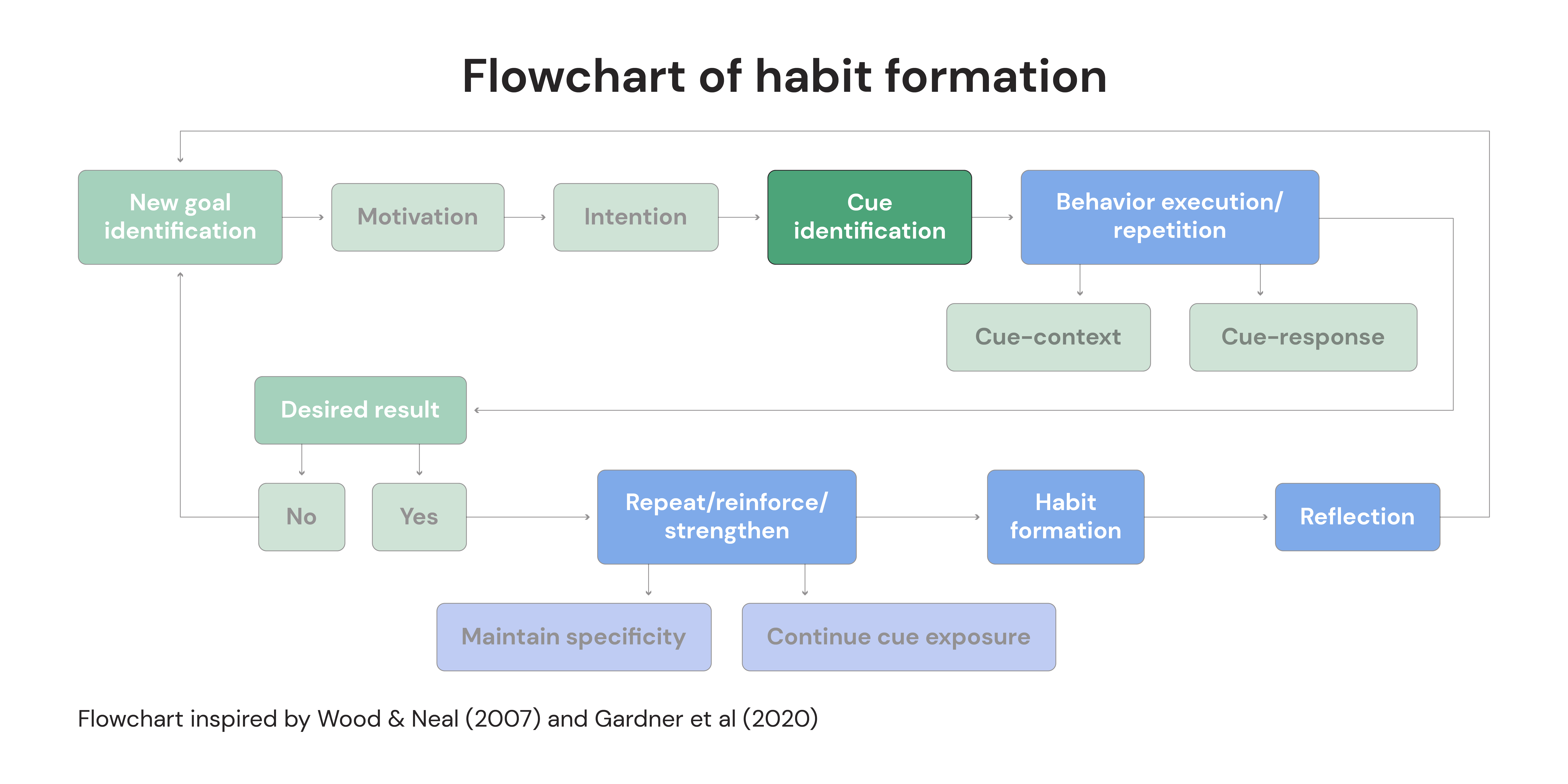
The role of the cue is paramount. The cue is the trigger that sets the process into action. It’s the whistle that starts the game. Pinpointing the cue is critical to initiating the habit-formation process.
Many people make the mistake of focusing on a habit’s action rather than the cue that is actually triggering the habit. The cue initiates the sequence supporting the habit action. Understanding the cue is the key to unlocking the subconscious. In our example of brushing your teeth before bed, the cue is not “brushing my teeth” – that’s the action.
The cue begins the action. In this case, we want the environment to serve as a cue to prompt the action. And more than that, we want to be really specific about the precise environmental factors. Research in habit formation tells us being vague is not so great for habit conditioning. A clear and specific set of circumstances significantly enhances habit conditioning. A statement like, “I want to brush my teeth every day” is too vague and could create obstacles. A better cue statement would be: “When I walk into the bathroom at night, I will brush my teeth before doing anything else.” This eliminates ambiguity. The specificity cuts through the noise and creates the right atmosphere for habit conditioning. The moment you enter the bathroom, the cue initiates the subsequent events that follow. This principle will become increasingly important as we explore routines and habit stacking in the fourth article.
Sometimes, perceived failures in habit actions are actually due to poorly chosen cues that don’t suit one’s specific circumstances. Identifying an appropriate cue is a challenge. It’s common for the initial cue to be imperfect; refining it is a part of the process. This aspect of habit formation is particularly tricky. Even if the desired actions themselves are straightforward, selecting the right context for them can require trial and error. Here is a short chart to help you understand the difference between vague and specific cues.
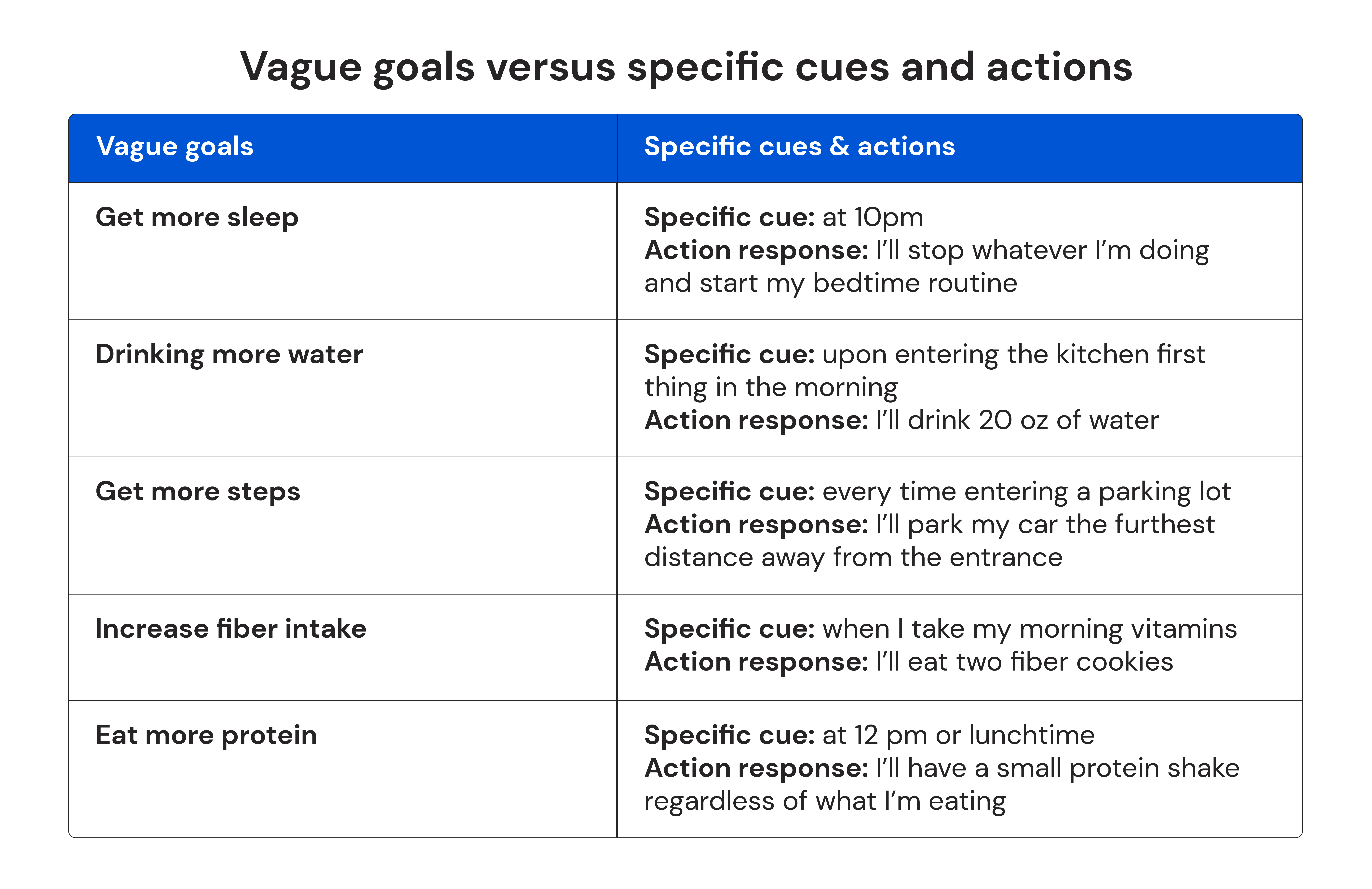
Selecting the right cue is key, especially for complex habits. You can’t set up a cue for “losing body fat.” Instead, it requires breaking down the goal into smaller, actionable steps, starting with specific behaviors. For instance, a habit like “avoiding liquid calories” could be a good starting point. Once this becomes ingrained, you can sequentially tackle each subsequent habit that leads you closer to your ultimate goal. This approach may present challenges for those who find it difficult to shift between detailed and broader perspectives. But if you can get good at specific cue selection, it’s a big win for your habits.
Last, choose triggers that seamlessly integrate into your home, lifestyle, or work environments. Your cues need to be in convenient locations, and they need to be consistent and identifiable. We’ll delve deeper into this topic in the final article of our series. But, for now, the takeaway is to set yourself up for success by choosing easy and specific cues.
- Cue identification: “The action of walking into my bathroom in the evening, before bedtime, will serve as the immediate trigger for brushing my teeth.”
Behavior execution and repetition
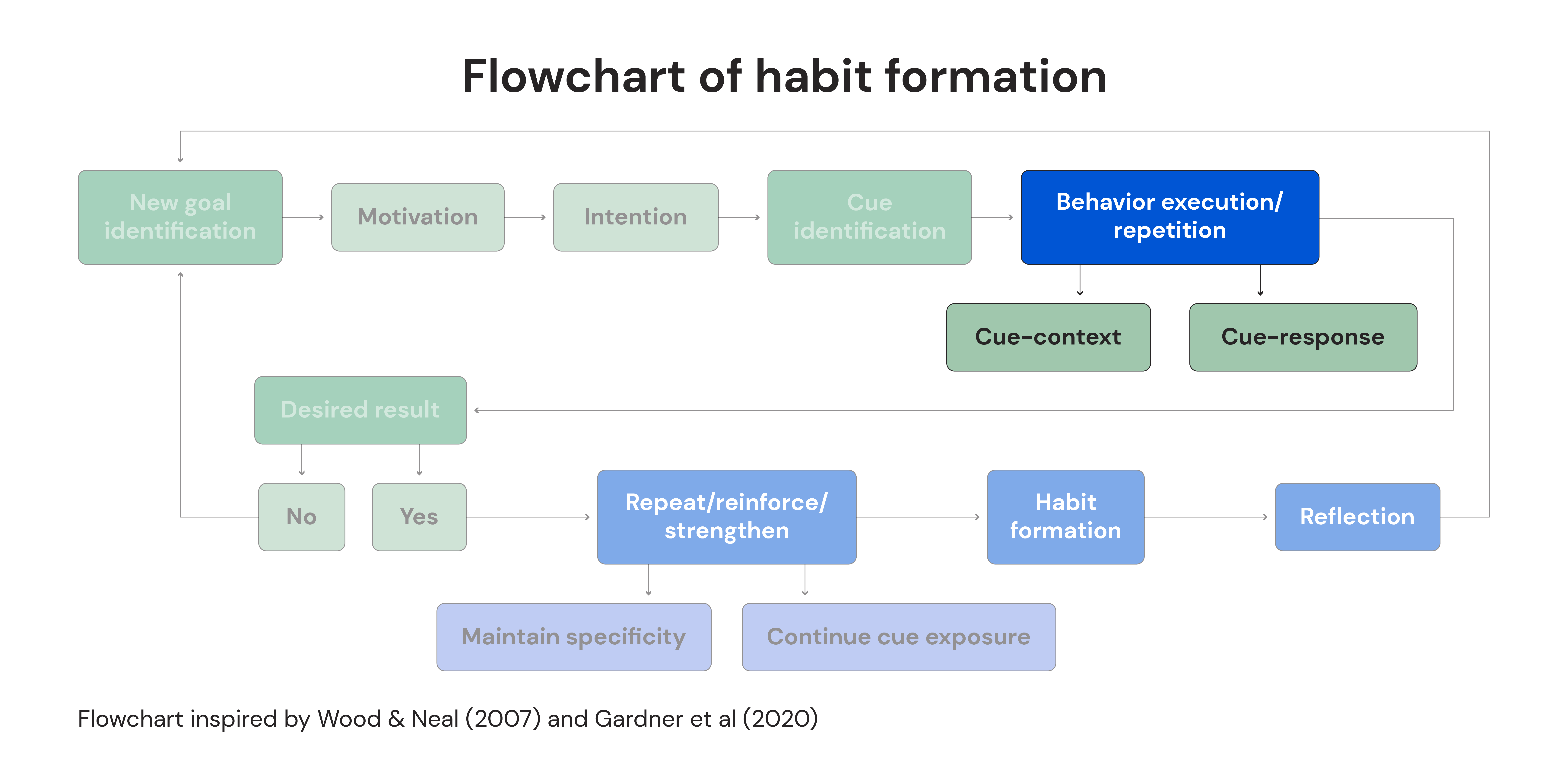
This stage is where the action part of your habit materializes. To caveat, behavior execution also interacts with the cue context and response. Although we’re examining each component separately, it’s important to recognize that these elements often intertwine quickly. As a result, some of this might sound familiar, or sound like the same idea phrased in a slightly different way. However, it’s important to examine the small differences in order to better understand the nuance of your habits.
With that caveat, we are now in the action phase of habit formation. To understand the significance of cue context and response, let’s examine the definition of a habit provided by Orbell and Verplanken: “Action repetition in a consistent cue context slowly results in the formation of a cue-response association in memory.”
Remember, our example goal is tooth-brushing. The cue is entering the bathroom in the evening. Using the definition:
Action repetition (brushing your teeth every night immediately upon entering the bathroom) in a consistent cue context (entering the bathroom in the evening) slowly results in the formation of a cue-response association in memory (over time, without thinking, you brush your teeth the moment you enter the bathroom in the evening).
In habit formation, cue-contextuality means how, where, and when you attempt to condition the habit matters, and it matters a lot. Inconsistency in habit training or attempting a complex goal rather than a habit complicates the development of automatic responses. The specifics, the order, and the routine all matter to successful habit formation.
For example, in 2012, Judah et al explored the mechanisms behind the habit formation of dental flossing. They conducted a study with 50 participants, each randomly assigned to incorporate flossing into their dental hygiene routine before or after brushing their teeth. Over eight months, the study monitored how often participants flossed and the strength of their flossing habit. Those instructed to floss after brushing did so more frequently and scored higher on habit strength than those who flossed before brushing.
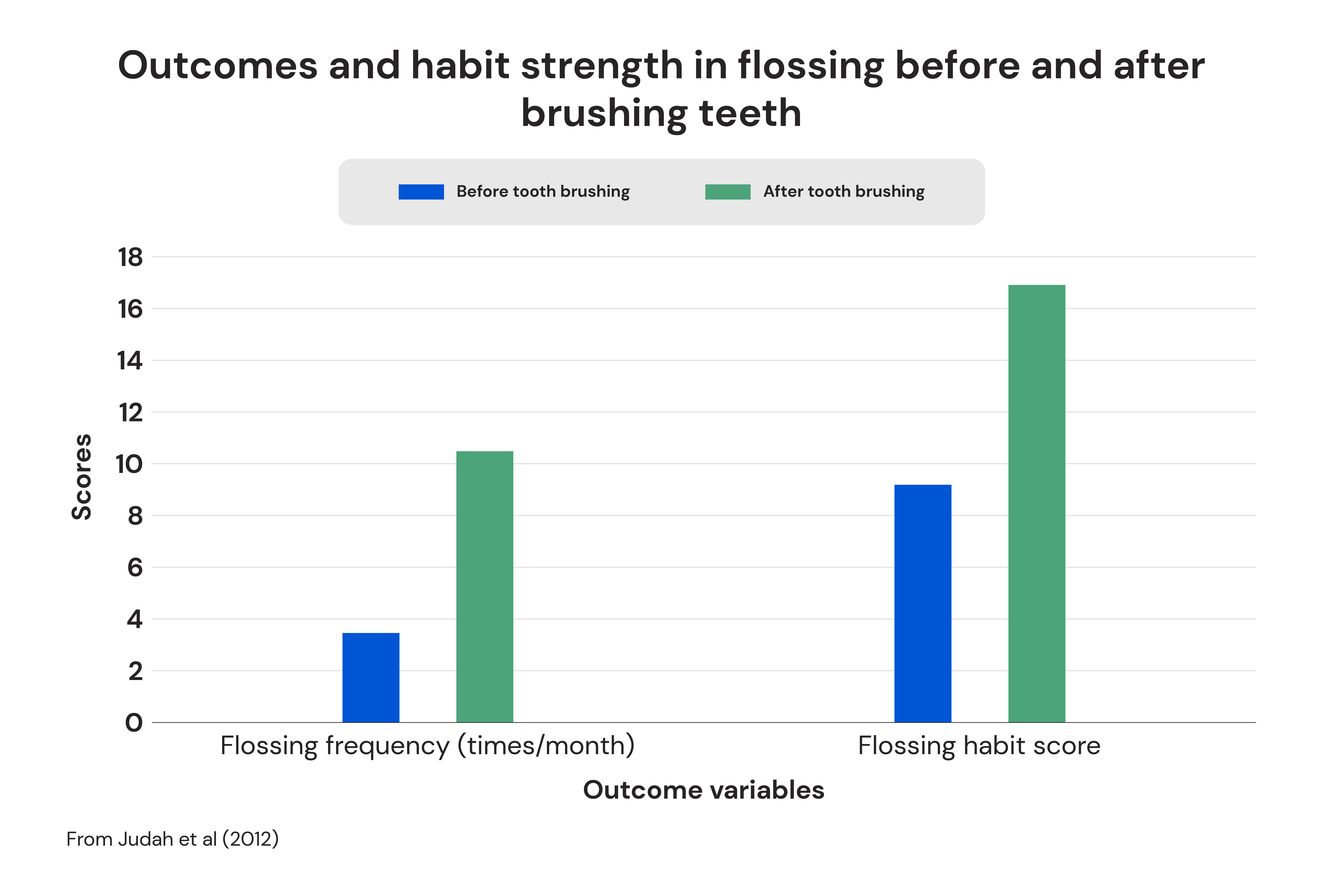
The key insight from this research is not merely the timing of flossing within the dental hygiene routine, but also the role played by the presence of an already established habit and cue. Tooth-brushing is an established routine for most people, so it can serve as a powerful and reliable cue to trigger another behavior (like flossing). The success of this timing likely stems not from a random preference for flossing after brushing, but from brushing serving as a strong cue for flossing. Aligning new habits with existing ones is a powerful tool. We will cover this more in the next article when we talk about routines and habit stacking.
The flossing study does not specify the time of day or order that is needed to execute a behavior, but there is likely a correct order or timing for your routine and pre-existing habits.
- Action repetition: I will brush my teeth every night immediately upon entering the bathroom.
- Cue context: The act of entering the bathroom in the evening will serve as my trigger.
- Cue response and memory association: Gradually, entering the bathroom in the evening will automatically prompt me to brush my teeth without the need for conscious thought.
Desired results
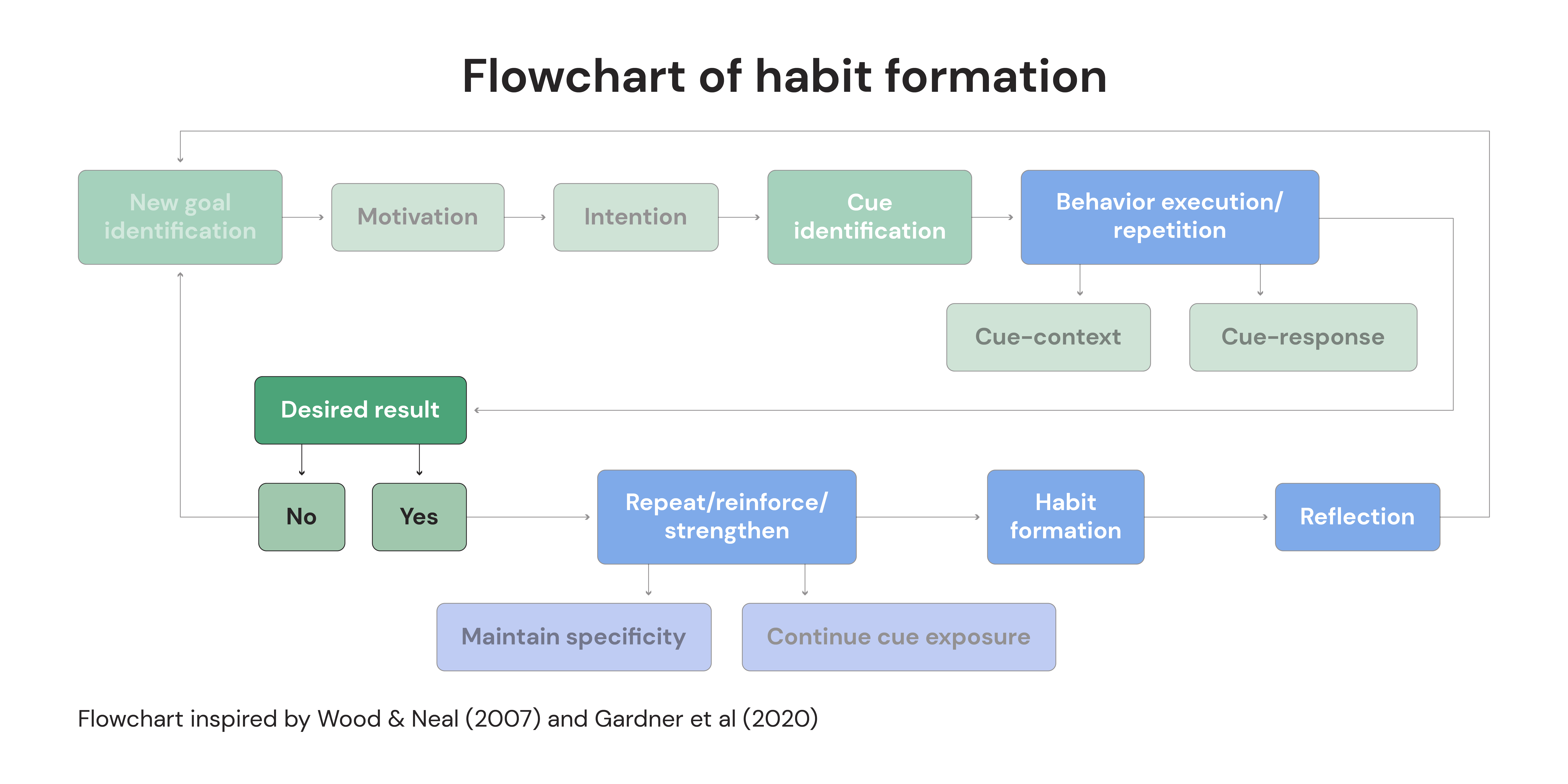
The result is the outcome of your attempt to form a habit, but it doesn’t mean that you have achieved complete success in habit formation quite yet. It’s more of a middle assessment. Has your cue been firing your desired habit action? If you successfully carry out the cue/action in sequence, you can progress toward making the behavior a habit.
For instance, if you consistently brush your teeth immediately upon entering the bathroom each evening, this indicates the process is working. Therefore, you should proceed to reinforce this behavior with repeated action.However, let’s say you didn’t achieve the cue/action. This is a great time to restart the process and pinpoint the failure point. Was the goal too vague? Was your motivation too low, or was the satisfaction gained from the outcome insufficient? Is the habit too complex and needs to be broken down into less complicated bites?
There are numerous potential points of failure in this process, and while it’s not feasible to address each one, I do want to zoom in on rewards.
As mentioned, habits should be conditioned to assist our goals, encompassing everything from health to beliefs and dreams. This concept is straightforward in theory but can be incredibly challenging to implement and sometimes hard to recognize, especially if the reward is not immediately gratifying. For instance, our goal of brushing our teeth more often is relatively simple in terms of execution, and the reward is immediate and clear. However, the goal of losing body fat is more complex. It is a lengthy process that is often uncomfortable, and there may be times when individuals doubt the efficacy of the approach. These doubts can also engage with various social and personal pressures, making the reward system unclear and our purpose lost.
When it comes to conditioning habits, especially for scenarios that require sacrifice, it’s useful to revisit the concept of intention moderators discussed in the second article. What are your aspirations for yourself, your family, and your future? Are your goals justified? Furthermore, can the task be enhanced with additional rewards or benefits? Can you treat yourself to milestone rewards? Can you make the sacrifice stints shorter in duration? What strategies can you employ to motivate yourself to persist through the conditioning of habits that can be unpleasant?
If the desired result has failed, consider it an opportunity to explore a different viewpoint on habit formation.
- Desired result achieved? No: “Brushing teeth immediately upon entering the bathroom is not going as planned, so I’ll try a new cue. I never forget to wash my face at night. So, I’ll place my toothbrush beside my face wash, and brush my teeth immediately after I finish washing my face .”
- Desired result achieved? Yes: “Each evening, I successfully brush my teeth the moment I step into the bathroom.”
Repeat, reinforce, and strengthen
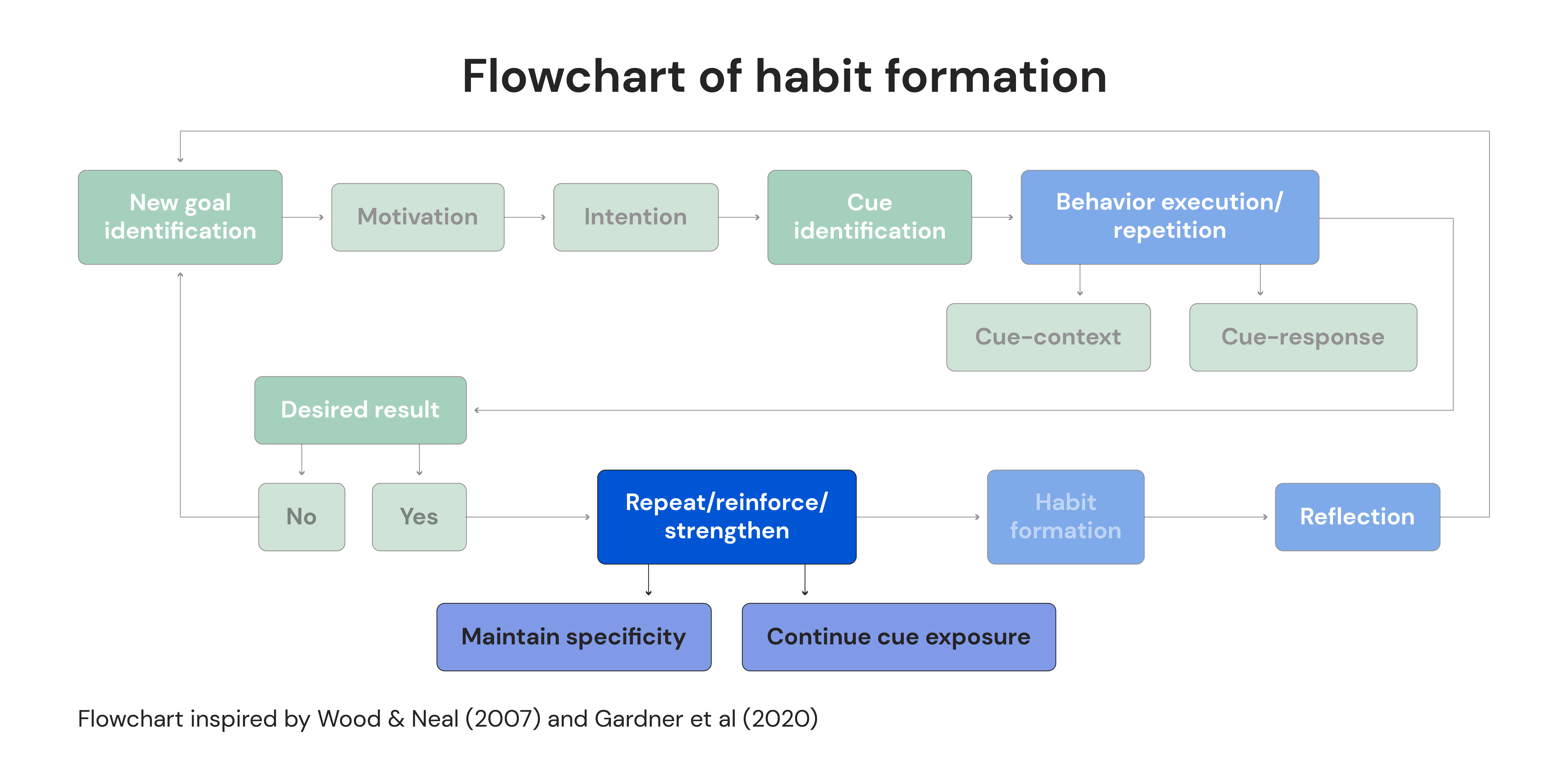
If you’ve successfully executed the cue-behavior sequence, you are on the path to forming a habit. The priority now is ensuring your cue exposure and specificity are constant.
The two major challenges people often face are a lack of understanding of the time required to form habits and the increased conscious effort needed as the habit becomes more complex. The path to habit formation is unique to each person and can depend on various factors, including the nature of the habit and individual differences. As I will discuss in more detail in the next article, the time it takes to form a habit is not fixed. There is no set number of days, and research suggests that the more complex the habit, the longer it can take to form. Therefore, when it comes to forming more complex habits, be prepared to allocate more time.
While the cue aspect of habits is usually brief and straightforward, the action component varies significantly. Execution of action can range from quick activities like brushing your teeth to longer ones, such as a 45-minute gym session. Clearly, the latter requires more time, commitment, and effort. This is why it’s important to concentrate on all aspects of intentions, moderators, and “if-then” plans, and to develop a support system wherever possible. This includes a combination of established habits, rewards, environmental setup, and anything else that can enhance your chances of consistent repetition for as long as it takes.
Last, you might start feeling confident and be tempted to alter your routine, such as moving a habit from routine-based to frequency-based (e.g., switching from brushing your teeth in the evening to once a day). Try to resist switching things up. Changes to the habit formation plan should only be made after careful consideration and confirmation that the new approach is superior. During this stage, embrace the concepts of repetition, steadiness, and a bit of monotony.
- Repeat, reinforce, and strengthen: “Over the past few weeks, as I enter the bathroom before bed each evening, I have consistently brushed my teeth right away.”
Habit formation
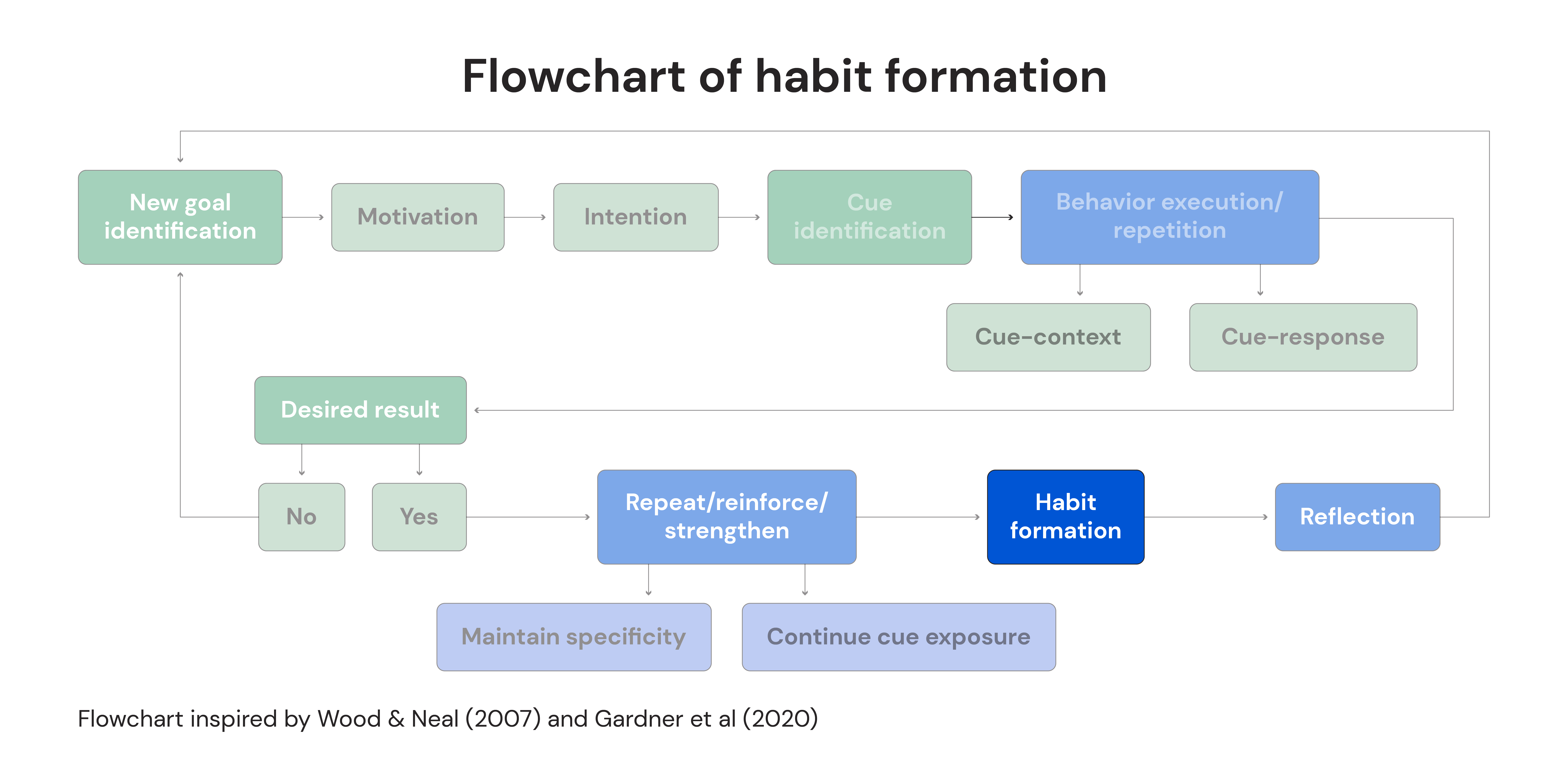
The habit formation process is complete when you achieve automaticity. This means that you’ve repeated the action enough that it can now be performed without conscious deliberation. In the toothbrushing goal example, you have achieved automaticity when you enter the bathroom in the evening and brush your teeth without thought or intention several nights in a row.
That said, sustaining a new habit requires not just reaching the point of automaticity, but also maintaining the conditions supporting the automatic behavior. This means the cues must remain consistent and stable over time, not just during the habit formation phase. So, as long as you wish to maintain the habit, all the pieces must stay in place. This is why choosing habits that align with your lifestyle is important. Your cue needs to stay engaged until you desire to retire the habit.
Generally speaking, habits tend to hit a holding point, a peak level of strength, and stay there unless there’s a drastic shift in routine. In exploring the practical application of this in research, Watson et al conducted a study with older adults who had recently undergone dental rehabilitation. The participants were divided into two groups with a total of 54 participants. The intervention group (n=27), who attended three sessions over six weeks, received tracking sheets and were guided on how to set goals for increasing fruit, vegetables, and whole grains. The control group (n=27) received standard dietary advice through a leaflet.
Researchers monitored the impact of automaticity on the participant’s food choices over six weeks, with follow-up assessments at four and eight months. The group that received guidance and education on eating habits began choosing fruits, vegetables, and whole grains and demonstrated improved automaticity in healthy eating compared to the control group.
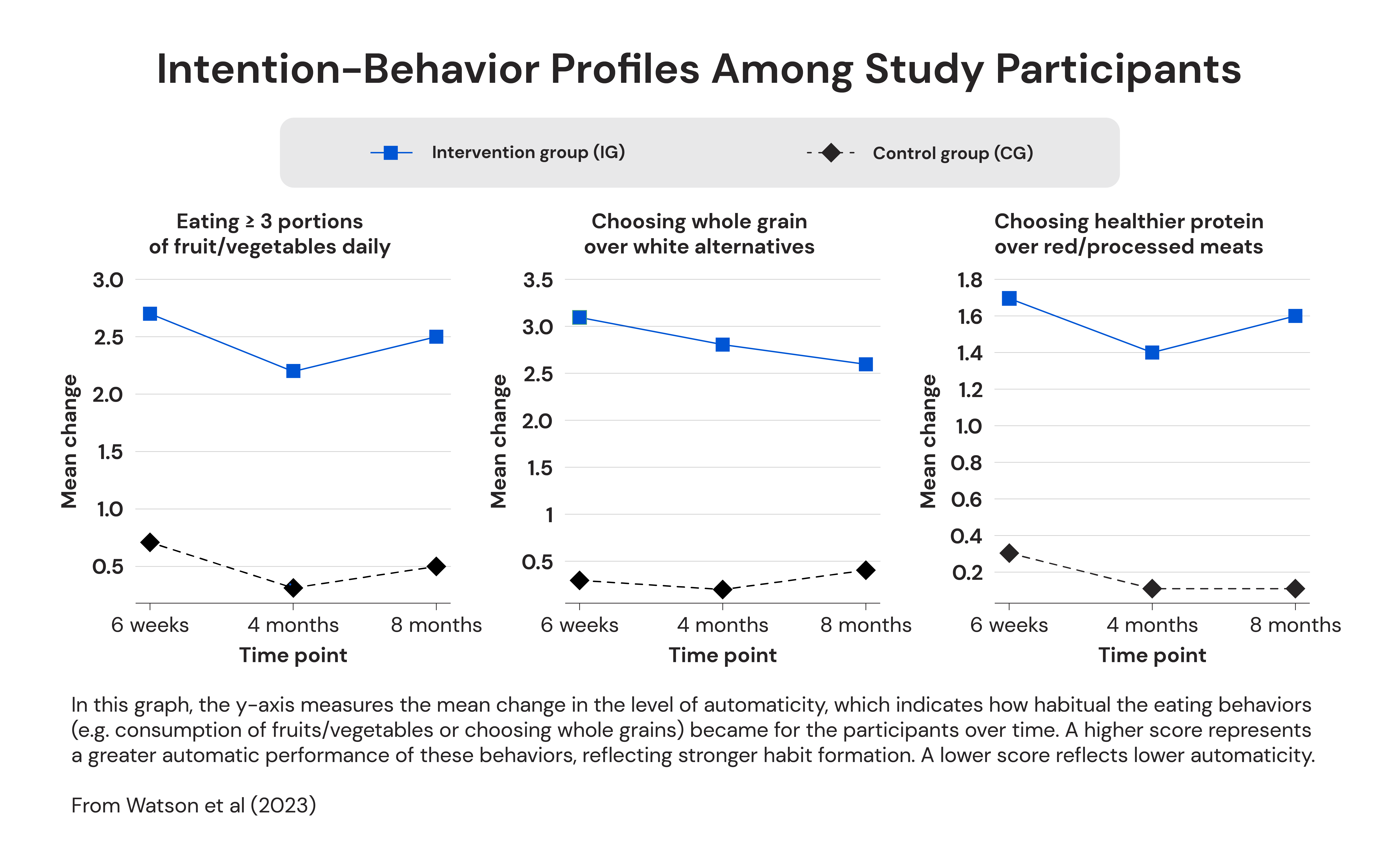
The intervention showcased the effectiveness of educational content focused on habit-building for achieving relevant goals. Note that both groups had intention moderators that aligned with their goals to eat better, meaning a key difference could be the incorporation of automaticity in behavior.
- Habit formation: “It took four weeks before I brushed my teeth upon entering the bathroom without consciously thinking about it for the first time. Even then, I continued to exert a conscious effort, but in the following weeks, I increasingly found myself not thinking about it and just doing it. After eight weeks, the behavior has become more consistently automatic.”
Reflection
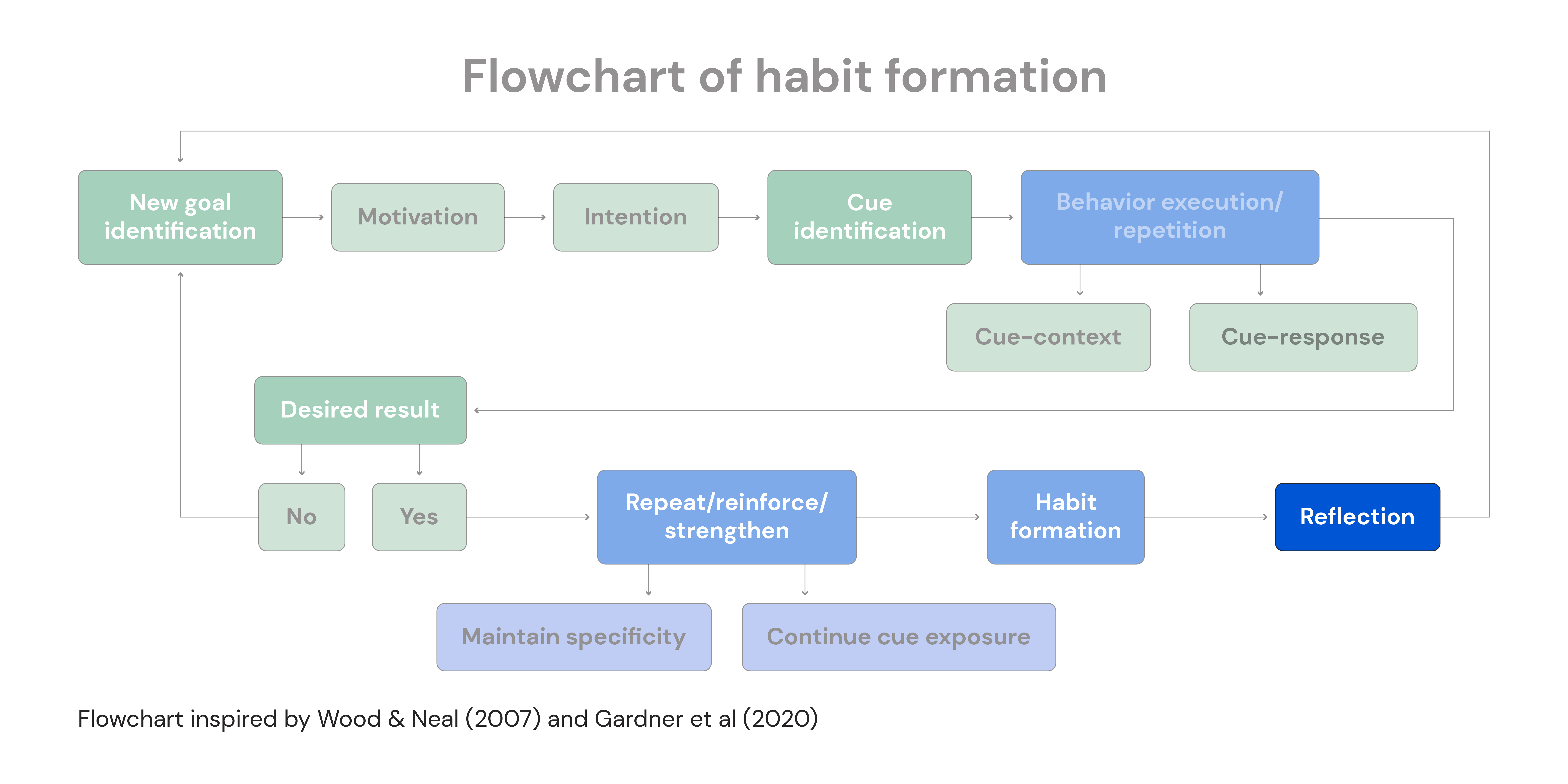
So, you’ve successfully conditioned a habit. It’s a big deal, and we should acknowledge and reflect on what worked and what didn’t. Reflection also provides a space to consider how that habit affects your life and whether the habit you created can co-exist or support other habits or behavior goals.
Hopefully, you see how each step serves a purpose and moves us from wanting something to actually doing it. Remember, success in habit formation hinges on being clear and specific about your goals. Avoiding vague cues and striving for consistency in triggers and locations is important. Additionally, we need to give ourselves a lot of time and repetition to build these habits, particularly when the habits involve more complex steps or barriers.
Ask yourself: What worked well? What didn’t? Where can you integrate other habits? We will delve into some of these aspects when discussing routine and environment. Ultimately, if you have purposefully conditioned a habit, it indicates you’ve successfully engaged with a powerful subconscious process.
- Reflection: It’s been three months, and I still brush my teeth in the evenings when I enter the bathroom. I feel really happy about the state of my dental hygiene and toothbrushing habits. I never had a problem in the morning, but I would do other things in the evening and sometimes forget to do it. That doesn’t happen now. I think I’d like to focus on creating a better habit around flossing and try to do it immediately after brushing my teeth in the evening.
And those are the mechanics of habit formation!
Now, let’s apply the system you’ve learned to goals that are likely more relevant to you as a MacroFactor reader. We will focus on the goals from the case studies we have been tracking throughout this article series. By using these specific examples, you’ll be able to see how the principles of habit formation can be tailored to fit different situations, whether they relate to nutrition, physical activity, or any other aspect of health and wellness.
Case Studies:
I’m sure you remember Casey and Riley from the case studies in the first two articles of this series. Casey is trying to develop a habit of walking after dinner, and Riley is trying to cut down on unwanted snacking. Let’s pick these threads back up to see how these concepts apply to the habits they’re trying to build.
How to condition a new habit
While the detailed breakdown of habit formation steps might seem excessive, that’s exactly the intention. Habit formation is, by nature, repetitive. The point of these exercises is to show you that any habit can be successfully developed if you understand each step of the process. In this instance, we’re applying the methodology to Casey’s goal to illustrate their full path of habit formation. These steps show progression from setting a new goal to habit formation success. Casey’s case study is still unfolding, but this provides a solid framework for how their habit formation could progress, alongside the insights shared throughout the article.
- New goal: Walk for 30 minutes every day after finishing dinner until I have automaticity.
- Motivation: My daily steps are low. Walking can help with both weight management and general health.
- Intention: I intend to walk for 30 minutes every day after dinner.
- Cue identification: When I take my plate into the kitchen, I will use this as a trigger to engage the action of going for a walk.
- Behavior execution / repetition: After taking my plate to the kitchen, I will walk for 30 minutes after dinner.
- Cue context: I get up from my chair, grab my plate, take it to the kitchen, and set it in the sink.
- Cue response: I head outside (or to my treadmill) to walk for 30 minutes.
- Result: Did I walk after dinner every day for 30 minutes?
- No: I did not walk after dinner. I don’t like dirty dishes sitting in the sink after dinner. So, I will try walking after washing the dishes and change my habit plan to reflect that.
- Yes: I walked after dinner for 30 minutes.
- Repeat, reinforce, and strengthen: I’ve walked after dinner for 30 minutes six times this week.
- Maintain specificity: I put my dish in the kitchen six times this week and then went for a walk.
- Continue cues exposure: I eat in the same spot and put my plate in the same spot when I’m finished. Thus far, everything feels easy and repeatable.
- Habit formation: It took roughly five to six weeks until this walking habit was automatic. Over the last six months, I have walked almost every evening after dinner. I do not have to make a conscious effort to walk after dinner now; it just happens.
- Reflection: I found implementing the habit of walking after dinner easy. The few times the habit was interrupted, I went for a walk slightly later with no issue. I feel confident that I’ll walk after dinner unless something drastic changes.
How to use these steps for breaking bad habits
In the second article of this series, I discussed the complex nature of breaking habits. Once learned, it’s very difficult to unlearn a habit. Therefore, when attempting to break a habit, it’s best to adopt a similar strategy as the one we use to make habits.
While that might seem bizarre, most success in “breaking” habits is in habit substitution, particularly when the cues triggering the habit are unavoidable. For example, if you habitually snack on a specific item every time you enter the kitchen, the cue – entering the kitchen – will inevitably continue to be a part of your life. While you might initially try to disrupt and disengage from the habit, transitioning to habit substitution could be the next step if this proves ineffective. An example of substitution could mean choosing a lower-calorie snack or reducing the quantity of the higher-calorie item.
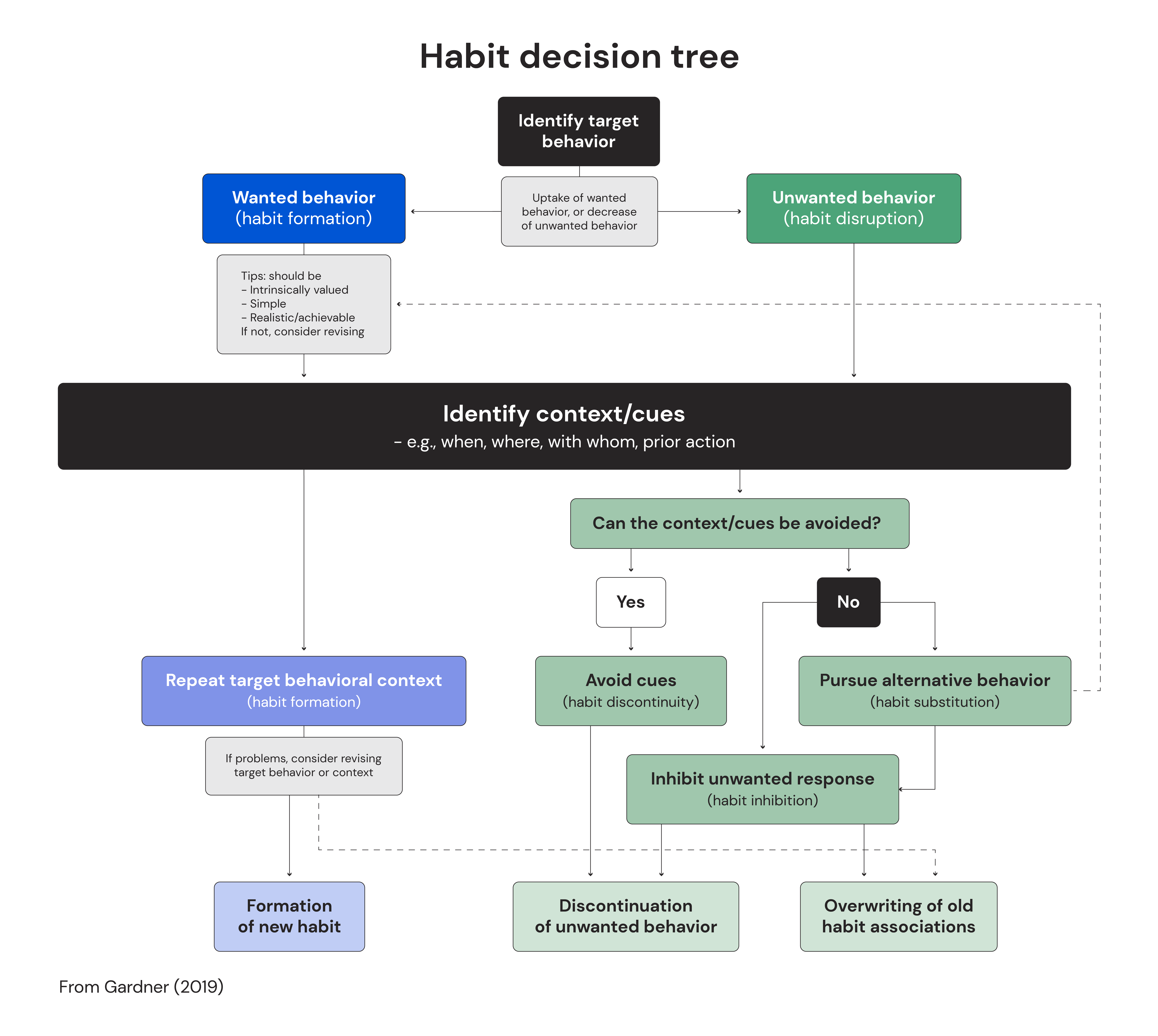
With that, now we will use Riley’s case study and their goal of wanting to stop eating high-calorie foods while watching TV.
- New goal: Stop snacking on high-calorie foods while watching TV or streaming movies.
- Motivation: I’ve noticed weight gain and want to halt that and decrease my overall body fat level.
- Intention: I intend to avoid eating high-calorie snacks while watching TV. If I must snack, I will choose my pre-selected alternative items.
- Cue identification: Sitting down to watch TV or scrolling/watching videos on my phone triggers my desire to snack. I will not snack or replace my snacking with a better item when this happens.
- Behavior execution / repetition:
- Cue context: The act of sitting down with the remote control in hand and turning on the TV or starting a movie.
- Cue response: Opting for a lower-calorie food item or beverage if abstaining isn’t working.
- Result: Did I manage to avoid high-calorie snacking while watching TV?
- No: I did sometimes, but not consistently. I also didn’t do well at all on the weekends. I noticed I did worse when I tried to stop altogether or didn’t have alternatives.
- Yes: I stopped eating high-calorie snack foods while watching TV.
- Repeat, reinforce, and strengthen: I’ve succeeded every day this week and haven’t had any more high-calorie foods.
- Maintain specificity: I’ve not had high-calorie snacks while watching TV every day this week.
- Continue cues exposure: I watch TV or movies sitting in the same spot but have changed my routine by introducing new, healthier habits instead of snacking.
- Habit formation: It took me a few weeks until the foods I chose in place of high-calorie snack foods felt “normal” and happened without much thought.
- Reflection: I found it surprisingly easy to switch out my high-calorie food habit with snacking on lower-calorie foods. There were a few times I didn’t have any food and drank tea instead. I have also stopped gaining weight. With that said, I haven’t lost much weight, and I do think I still eat too much while watching TV. I feel the quality of my nutrition is better; however, I still need to work on cutting my overall calories to lose fat.
What’s next?
Technically, you can take the information from these three articles and succeed in habit formation. However, I invite you to stick around because the final two articles look at optimizing our routine and creating an environment for success. This is especially important because the more complex our habits become, the harder they are to establish or “break” once formed. How we integrate them into our lifestyle is a big piece of putting things together.
For now, let’s examine our next homework assignment and see how we can apply what we’ve learned.
Homework assignment: studies of habit formation
In our first article of the series, we examined the dual nature of habits: they can be either constructive or counterproductive to our goals. Hopefully, this prompted you to identify a goal you wish to achieve or modify through habit manipulation.
The second installment emphasized understanding our existing habits more deeply, focusing on the reasons and motivations behind our desire to change these habits. It also guided the creation of action plans to reinforce positive habits or address and overcome obstacles to habit change.
This section will apply what we’ve learned regarding the mechanics of habit formation to our case studies.
Case study 1: Increase physical activity via walking after dinner
Casey is a 44-year-old freelance graphic designer who works from home and wants to counteract a sedentary lifestyle by incorporating more physical activity into their daily routine. Their objective is to add a 30-minute walk after dinner each day.
Specific cue identification: ”When I take my plate into the kitchen, I will use this as a trigger to engage the action of going for a walk.”
List 3 behavior response supports (Implementation Intentions):
- I will keep my shoes by the door.
- I’ll keep my phone charged to have entertainment to listen to while walking.
- If I have something else to do after dinner, I will immediately walk when the other event ends.
Tracking method: “I will track my steps every day to see that the totals increase from then on, and then keep them similar throughout the next few months of monitoring.”
Case study 2: Eliminate high-calorie snacking while watching TV/streaming
Riley is a 30-year-old account manager who tends to snack on high-calorie food while watching TV or streaming movies. Riley’s goal is to eliminate this habit, hoping it will also help meet their goal of losing 20 pounds of fat.
Specific cue identification: ”Sitting down to watch TV or scrolling/watching videos on my phone triggers my desire to snack. When this happens, I will not snack, or I will replace my snacking with a better item.”
List 3 behavior response supports (Implementation Intentions):
- I will buy low-calorie snacks to replace the high-calorie snacks.
- I will keep tea and honey stocked for when I want a beverage snack.
- I will use the weekends to prep or buy the items I want around on the weekdays.
Tracking method: “I will track my nutrition in an app to ensure I keep myself accountable to achieve my goal. However, I will give myself a small amount of leeway for imperfection and log it via memory at the end of the day.”
Your assignment:
At the end of each article, take a moment to document each insight lesson for your journey. For this article, try to answer the assignment questions that are also asked of our case study participants.
Bonus homework: Fill out your habit loop steps and try to forecast your habit goal’s desired results. Can you anticipate any barriers? How long do you think it’d take you to form this habit automatically? Are you seeing your cues specifically and clearly? It might take a little time to dive into this, but if you envision your habits this way, you can apply these strategies to anything you want to change.

